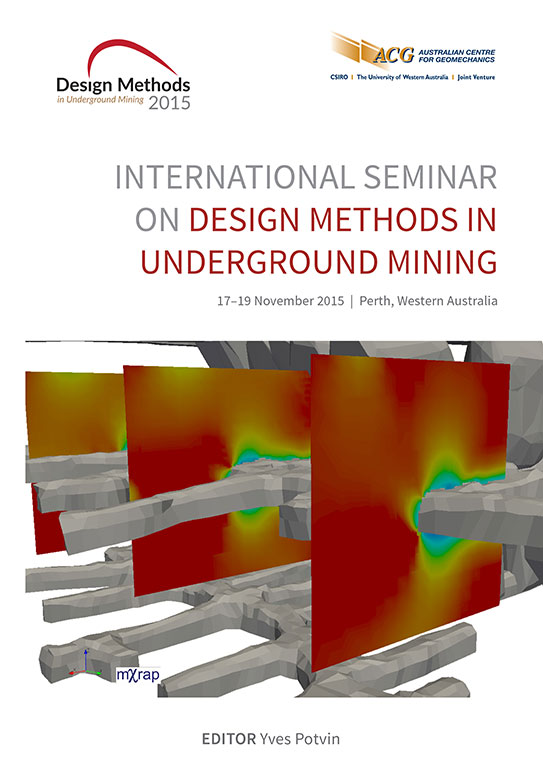Design and application of an efficient mining method for gentle-dipping narrow vein at Kafang Mine

|
Authors: Gao, F; Zhou, KP; Deng, HW; Yang, NG; Li, JL |
DOI https://doi.org/10.36487/ACG_rep/1511_17_Gao
Cite As:
Gao, F, Zhou, KP, Deng, HW, Yang, NG & Li, JL 2015, 'Design and application of an efficient mining method for gentle-dipping narrow vein at Kafang Mine', in Y Potvin (ed.), Design Methods 2015: Proceedings of the International Seminar on Design Methods in Underground Mining, Australian Centre for Geomechanics, Perth, pp. 293-305, https://doi.org/10.36487/ACG_rep/1511_17_Gao
Abstract:
It is recognised that a gently-dipping narrow vein is hard to be exploited due to the difficulties in ore drawing and operating large mining equipment in the restricted stoping space. Therefore, considerations are required to adopt an efficient mining method that is capable of dealing with the irregular boundary of this kind of orebody, resulting in a high recovery rate while minimising the ore dilution and the preparations prior to stoping. In the case of mining the low-grade ore cluster I-9 at the Kafang Mine of Yunnan Tin Industry Company, China, the requirements of mining at a large scale poses another challenge. For the ore cluster I9, there are four layers of ore bodies, with an average thickness of 2.22 m and dip angles in the range of 1520°. The average grade of the main commodity (Cu) is only 0.58%. After evaluating and comparing different mining methods based on a geotechnical investigation, rock mechanics tests and rock mass classification, the efficient breast stoping (overall mining method) was selected. Specifically, the stopes along the strike direction were arranged at an angle of 45°, with respect to the dip direction (termed apparent dip layout henceforth). This layout enhanced the operating ability of loadhauldump (LHD) and other trackless equipment. With a Sandvik drilling jumbo DD210L and a TCY2A diesel LHD, continuous mining of the full thickness of the orebody significantly increases production when compared with previous mining practice. The ore loss decreases from 14.6 to 8.2%. The extraction-to-cut ratio is down from 20.69.2 m/kt. The mining cost is reduced from CNY 158.88 to CNY 104.35 per tonne. This mining method has the potential to be widely used to exploit similar orebodies.
References:
Barton, NR, Lien, R & Lunde, J 1974, ‘Engineering classification of rock masses for the design of tunnel support’, Rock Mechanics, vol. 6, no. 4, pp. 189-239.
Bieniawski, ZT 1974, ‘Geomechanics classification of rock masses and its application in tunnelling’, Proceedings of the Third Congress of the International Society for Rock Mechanics, Advances in Rock Mechanics, National Academy of Sciences, Washington DC, vol. 2, part A, pp. 27-32.
Caruso, B, Mirtskhulava, M, Wireman, M, Schroeder, W, Kornilovich, B & Griffin, S 2012, ‘Effects of manganese mining on water quality in the Caucasus Mountains, Republic of Georgia’, Mine Water and the Environment, vol. 31, no. 1, pp. 16-28.
Cheng, HJ 2008, ‘Practice of the gently dipping thin orebody mining method’, Jilin Geology, vol. 27, no. 4, pp. 74-77.
Ding, MF, Wang, Z, Wang, DW, Wang, SH, Liu, YY & Qin, WL 2014, ‘The optimization of mining method scheme for gentle dip and filminess ore body’, Gold Science and Technology, vol. 22, no. 1, pp. 56-59.
Guo, JF & Wang, HS 2010, ‘Practice and review on mining technology of gently inclined thin ore-body of Tweefontein Chromium Ore in South Africa’, Metal Mine, no. 2, pp. 18-21.
Guo, YH, Hou, KP & Yang, BJ 2014, ‘Roof stability analysis of sublevel open stope method in gently inclined and extremely thin orebody’, Electronic Journal of Geotechnical Engineering, vol. 19, pp. 2277-2288.
Mathews, KE, Hoek, E, Wyllie, DC & Stewart, S 1981, Prediction of stable excavation spans for mining at depths below 1,000 metres in hard rock / Golder Associates, CANMET Library & Documentation Services Division, Vancouver.
Potvin, Y, Hudyma, M & Miller, HDS 1989, ‘Design guidelines for open stope support’, Bulletin of the Canadian Institute of Mining and Metallurgy, vol. 82, no. 926, pp. 53-62.
Stewart, SBV & Forsyth, WW 1995, ‘The Mathews method for open stope design’, Bulletin of the Canadian Institute of Mining and Metallurgy, vol. 88, no. 992, pp. 45-53.
Wang, LJ, Xue, TX, Chen, T & Wang, BH 2003, ‘Study on the mining method of gentile dip thin ore-body’, Gold Science and Technology, vol. 11, no. 3, pp. 44-47.
Yang, GT & Yuan, MF 2013, ‘A new machined mining technology of gently inclined thin orebody and its engineering practice’, Mining Research and Development, vol. 33, no. 3, pp. 1-3.
Yang, ZX, Mao, JW, Chen, MH, Cheng, MB & Chang, Y 2010, ‘Geology, geochemistry and genesis of Kafang copper deposit in Gejiu, Yunnan Province’, Acta Petrologica Sinica, vol. 26, no. 3, pp. 830-844.
Yi, XY & Wang, ZQ 2007, ‘Optimization of lane ways position in slightly inclined thin ore body’, Non-Ferrous Mining and Metallurgy, vol. 23, no. 4, pp. 17-20.
Zhou, KP, Guo, W, Deng, HW & Lei, T 2012a, ‘Optimum selection of mining methods based on TRIZ-FAHP theory’, Mining and Metallurgical Engineering, vol. 32, no. 2, pp. 1-4.
Zhou, KP, Li, JL, Lei, T & Guo, W 2010, ‘Innovation design of mining method based on TRIZ methodology’, Journal of Engineering Design, vol. 17, no. 6, pp. 401-405.
Zhou, KP, Zhai, JB, Gao, F, Hu, PL & Zhang, YM 2012b, ‘Study on optimizing stope parameters and false-inclined layout in the gentle dip thin ore-body’, Journal of Guangxi University: Natural Sciences Education, vol. 37, no. 2, pp. 376-381.
© Copyright 2025, Australian Centre for Geomechanics (ACG), The University of Western Australia. All rights reserved.
View copyright/legal information
Please direct any queries or error reports to repository-acg@uwa.edu.au
View copyright/legal information
Please direct any queries or error reports to repository-acg@uwa.edu.au